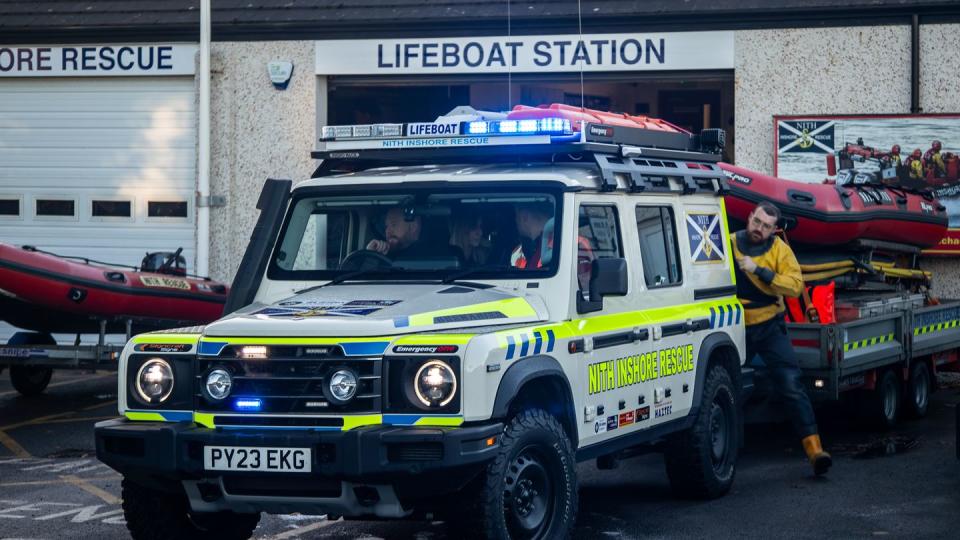Ineos Grenadier Is Ready for ’Life-and-Death Situations‘

Ineos Grenadier joins vehicle fleet of Nith Inshore Rescue in Scotland, replacing an older Land Rover Defender in the rescue vehicle role.
The Grenadier SUV, created by petrochemical giant Ineos, was designed in the style of the last-gen Land Rover Defender, and offers BMW inline-six engines.
During its development cycle the Grenadier has been tested by the International Federation of Red Cross and Red Crescent Societies (IFRC), with Ineos expecting the 4x4 to be a suitable replacement for other rugged SUVs in rescue fleets.
For years the classic Land Rover Defender has served as an ambulance, fire truck, and rescue vehicle in the UK and elsewhere around the world, even though it never quite made it stateside in that role. Now that the classic Defender is out of production, specialized rescue teams are looking for a replacement that will be just as rugged, roomy, and easy on the municipal wallet to run in their fleets.
One candidate is the Ineos Grenadier, which has already been tested with the International Federation of Red Cross and Red Crescent Societies (IFRC) in Dubai as part of its development program.
Now, Nith Inshore Rescue in Scotland has chosen the new 4x4 as its search and rescue vehicle, becoming the first emergency response Grenadier in the UK, and replacing an older Defender that has filled this role for years.
The service is one of the most active lifeboat stations in Scotland, located on the estuary of the River Nith near Dumfries, and launches its rescue vehicle and lifeboat when directed by the HM Coastguard Rescue Coordination Center.
"We deal with life-and-death situations, very harsh weather, and challenging terrain, so when it came to evaluating the options for a new support vehicle, there were few options and the Grenadier stood out, ticking all the boxes," said Peter Bryden, secretary of Nith Inshore Rescue.
The 4x4 has been upgraded for the role by specialist search and rescue equipment provider Emergency One, which equipped it with the needed gear including an extendable roof-mounted camera.
The Grenadier is powered by a choice of 3.0-liter BMW inline six-cylinder diesel and gas engines, making them economical for emergency fleets, while also being powerful enough to tow trailers while carrying extensive medical and rescue gear inside.
The four-door Grenadier isn't quite long enough to serve as an ambulance as outfitted in this particular instance, as its role is primarily that of a rescue and towing vehicle, with ambulance duties performed by other vehicles in the municipality.
"We were very impressed with the way it has been engineered and built to last, as well as how straightforward it was to convert it for this role. Together with our revitalized lifeboat, we expect it serve our team for the next 40 years," Bryden added.
Of course, the new five-door Land Rover Defender 130 could be suitable for this task as well, given the room for gear out back. But the Defender, while certainly large enough to carry a lot of gear, may be too expensive for emergency fleet budgets—certainly more expensive than the old Defender. Still, we expect to see the new Defender to continue joining police and specialized rescue fleets, at least in the UK.
The main question in the next few years in European search and rescue fleets is perhaps just when emergency vehicles of this type will be mandated to go electric.
Vehicles of its type are viewed as well-suited to becoming EVs in the coming years, as they serve a defined geographic area and spend hours of the day at their stations where they can be charged.
The smaller city and government cars in Europe and in the US are expected to be the first to be swapped out for EVs, and in some large metro areas this is already happening in municipal fleets. But more specialized rescue vehicles could remain gas and diesel-powered for quite some time, absent local government mandates.
Will we see various emergency vehicles go electric in this decade, or will gas and diesel-engined models remain in emergency fleets well past the point at which many consumer vehicles will become EVs? Let us know what you think.

 Yahoo Autos
Yahoo Autos 